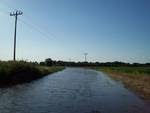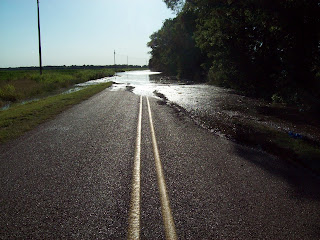Sharing Thoughts
John H. Walker has more than 35 years' newspaper experience. A Mississippi native, he has edited or published newspapers in six states, winning numerous awards. In 2008, he was named Louisiana Investigative Reporter of the Year and in 2009, his newspaper was named both Louisiana and National Newspaper of the Year. He is as a communications consultant and strong local contentl is the key to continued longevity for newspapers. He is an avid college baseball fan as well as a railfan.
Tuesday, May 24, 2011
Water falling in Yazoo County
According to the U.S. army corps of Engineers (USACE) website, the Yazoo River is beginning to recede slowly.
Robert Simrall, chief of water control for USACE in Vicksburg and one of our sources for flood projections, said the river has dropped about six inches since cresting on Saturday at 38.4 feet.
Simrall said water is still rising on the backwater side of the Yazoo Backwater Levee south of Rolling Fork. Simrall said it will probably be June 20 before the Mississippi River drops enough to allow for opening of the flood gate to release the backwater flooding.
As soon as possible, we will get an update from Harold Harton and our EYES on Wolf Lake to bring you up to speed.
Robert Simrall, chief of water control for USACE in Vicksburg and one of our sources for flood projections, said the river has dropped about six inches since cresting on Saturday at 38.4 feet.
Simrall said water is still rising on the backwater side of the Yazoo Backwater Levee south of Rolling Fork. Simrall said it will probably be June 20 before the Mississippi River drops enough to allow for opening of the flood gate to release the backwater flooding.
As soon as possible, we will get an update from Harold Harton and our EYES on Wolf Lake to bring you up to speed.
Labels:
Corps of Engineers,
flooding,
Harold Horton,
Rolling Fork,
USACE,
Wolf Lake,
Yazoo County Airport,
Yazoo River
Wednesday, May 18, 2011
Flood update from downriver - river reopened to traffic
The U.S. Army Corps of Engineers (USACE) in New Orleans announced about 10 a.m. (CDT) that 16 gates have been opened at the Morganza Spillway flood control structure. A flow of 108,000 cubic feet per second is now being diverted from the main channel of the Mississippi River.
There are 125 gates at Morganza and the Corps expects to eventually open between 30 and 35 of them.
The flooding being created by the spillway's opening on Saturday has been slowed by the extreme drought conditions plaguing that part of the state./ The New Orleans District of the corps announced 16 gates have been opened at the Morganza spillway, moving water through the structure at an estimated 108,000 cubic feet per second. Morganza has 125 total gates. The corps began opening them slowly on Saturday.
About 115 river miles to the south, 330 of the 350 gates at the Bonnet Carre' Spillway are open at Norco, diverting water from the river into Lake Pontchartarin in an effort to keep the levees from being overtopped in the Crescent City.
USACE also announced earlier today that it was opening the Mississiippi to traffic north of New Orleans. On Tuesday, the Corps had closed the river at Natchez.
There are 125 gates at Morganza and the Corps expects to eventually open between 30 and 35 of them.
The flooding being created by the spillway's opening on Saturday has been slowed by the extreme drought conditions plaguing that part of the state./ The New Orleans District of the corps announced 16 gates have been opened at the Morganza spillway, moving water through the structure at an estimated 108,000 cubic feet per second. Morganza has 125 total gates. The corps began opening them slowly on Saturday.
About 115 river miles to the south, 330 of the 350 gates at the Bonnet Carre' Spillway are open at Norco, diverting water from the river into Lake Pontchartarin in an effort to keep the levees from being overtopped in the Crescent City.
USACE also announced earlier today that it was opening the Mississiippi to traffic north of New Orleans. On Tuesday, the Corps had closed the river at Natchez.
Labels:
Bonnet Carre' Spillway,
Corps of Engineers,
Mississippi River flood,
Morganza,
Morganza Spillway,
Natchez
Updated photos from Wolf Lake and Good Hope Community are here
As promised, here are "current" photos from Wolf Lake and Good Hope communities ... there are six.
Also, here is an update from Harold Horton (from Monday) on the situation:
Harold said, "Three days to go prior to the crest at Vickburg. Can we make it?"
Also, here is an update from Harold Horton (from Monday) on the situation:
1. Water can be seen directly in front of Dad's (Guy Horton's) house. About 300 yards away.
2. Water can be seen back at the wood's behind Mrs. Bell's.
3. Water now covers the bridge at Shake on the Lake and likes 2 to 3 inches going in Shake on the Lake. Water is over the road just past the bridge going toward Yazoo City from Good Hope Community.
4. Water covers the road just past Club 21 going toward's Guy Horton's house.
5. Carter Road is covered with water and the road is blocked toward Good Hope Community. Water is going over the road at the end of Wolf Lake.
6. Water is coming up the ditch beside the old Dubois house.
7. Water is over the road going toward Lake City/Deerfield.
8. Water is over the road at the Airport and water is up to the edge of Terry Horton's house. Water is also on the runways at the Yazoo County airport.
Harold said, "Three days to go prior to the crest at Vickburg. Can we make it?"
 |
| Carter to the left, Wolf Lake to the right and water on all sides. |
 |
| Turn around, please |
 |
| Water lapping at Mrs. Bell's property |
 |
| With all the water, the road takes on a causeway-type look |
 |
| Carter Road |
 |
| Water creeps out of the woods onto the road, like a thief in the night |
Labels:
Carter Road,
Good Hope,
Yazoo County Airport
Subscribe to:
Posts (Atom)
